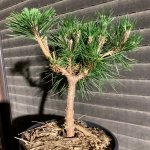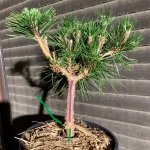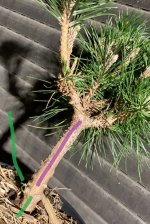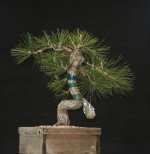flower_totem
Seedling
Hello all,
[Location: Southern Hemisphere. Melbourne, Australia]
My wife gifted this Japanese Black Pine (JPB) to me couple months ago, trunk is about 12mm thick. It had needles all over so I removed most of the bottom needle and cut off a branch on top in order to have a look at the trunk structure. A big mistake I know , I am a bit ahead of myself.
, I am a bit ahead of myself.
After reading and learning a lot, I figured I'll consult the collective wisdom here.

Thankfully, there's some bud growth at the lower position of the trunk. My initial thought was, let the whole tree grow and have the first bud as its first trunk change of direction movement and continue from there on.

It is actively growing now as it's summer here. I planned to move this into a 40cm wooden grow box next spring (Aug/Sep 2025) and plant it slanted for a couple years, then chop once desired branch thickness achieved.

My question are:
1) Those 3? or 4? branches on the top off the sacrificial branch [PURPLE], shall I cut off a few or leave it as it is ? What is best to divert some energy to the lower bud [GREEN]
2) What do I have to watch out for a better chance of pulling this off ?
Looking at a 3-6 years project, my thought now is a shohin but I'm all ears if there's better plan/suggestion. Not intended for show, happy for a good enough Bonsai, in to enjoy the journey.
Thanks in advance.
Edit: typo
[Location: Southern Hemisphere. Melbourne, Australia]
My wife gifted this Japanese Black Pine (JPB) to me couple months ago, trunk is about 12mm thick. It had needles all over so I removed most of the bottom needle and cut off a branch on top in order to have a look at the trunk structure. A big mistake I know
After reading and learning a lot, I figured I'll consult the collective wisdom here.

Thankfully, there's some bud growth at the lower position of the trunk. My initial thought was, let the whole tree grow and have the first bud as its first trunk change of direction movement and continue from there on.

It is actively growing now as it's summer here. I planned to move this into a 40cm wooden grow box next spring (Aug/Sep 2025) and plant it slanted for a couple years, then chop once desired branch thickness achieved.

My question are:
1) Those 3? or 4? branches on the top off the sacrificial branch [PURPLE], shall I cut off a few or leave it as it is ? What is best to divert some energy to the lower bud [GREEN]
2) What do I have to watch out for a better chance of pulling this off ?
Looking at a 3-6 years project, my thought now is a shohin but I'm all ears if there's better plan/suggestion. Not intended for show, happy for a good enough Bonsai, in to enjoy the journey.
Thanks in advance.
Edit: typo


